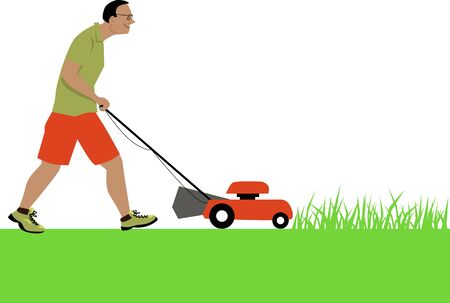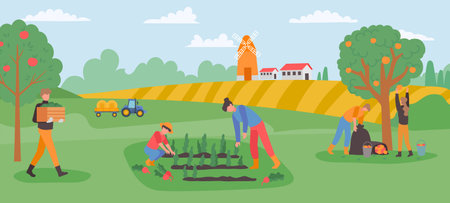1. Planning Your Low-Maintenance Landscape
Creating a low-maintenance yard starts with smart planning. Before you grab your shovel or buy plants, take some time to assess your outdoor space, think about how you use it, and design with your local climate in mind. A thoughtful plan can help you save hours of yard work and reduce long-term costs.
Understand Your Yard
Every yard is different. Start by observing your space throughout the day and in different seasons. Pay attention to these key elements:
- Sunlight: Which areas get full sun, partial shade, or full shade?
- Soil Type: Is your soil sandy, clay-heavy, or loamy? A simple soil test kit from a garden center can help.
- Drainage: Are there spots where water pools after rain? Poor drainage can affect plant health.
- Wind Exposure: Windy areas may dry out faster and need hardy plant choices.
Define Your Needs and Preferences
Your landscape should reflect how you want to use your yard. Ask yourself:
- Do you need space for kids or pets to play?
- Are you interested in growing vegetables or herbs?
- Would you like a quiet spot to relax or entertain guests?
This helps determine what features and elements are essential—and which ones you can skip to keep things simple.
Create Zones for Functionality
A well-organized yard groups similar functions together. Think of your yard in terms of zones:
| Zone | Description | Low-Maintenance Tips |
|---|---|---|
| Lawn Area | A small patch of grass for play or looks | Select drought-tolerant grass or consider ground cover alternatives |
| Sitting Area | A patio, deck, or shaded spot to relax | Pave with gravel or pavers to reduce weeding and mowing |
| Garden Beds | Beds for flowers, shrubs, or edibles | Add mulch to retain moisture and suppress weeds |
| Naturally Wild Zone | An area left mostly natural with native plants | No mowing needed—just occasional pruning |
Sustainability Matters
A sustainable landscape uses resources wisely. Choose plants that thrive in your local climate (also known as “climate-appropriate” or “regionally adapted” plants). Native plants often need less water, fertilizer, and care overall.
You can also collect rainwater using barrels, install drip irrigation for efficient watering, and use compost to enrich your soil naturally.
Quick Checklist for Planning:
- [ ] Observe sunlight patterns in your yard
- [ ] Test your soil type and drainage
- [ ] List must-have features based on your lifestyle
- [ ] Divide space into practical zones
- [ ] Choose native or climate-appropriate plants
A little planning goes a long way toward building a beautiful yard that works for you—not the other way around.
2. Choosing the Right Plants for Easy Care
One of the smartest ways to create a low-maintenance yard is by selecting the right plants from the start. Choosing native and drought-tolerant plants not only saves you time and money but also helps your landscape thrive with minimal effort. These plant types are naturally adapted to your local environment, meaning they need less water, fertilizer, and attention compared to high-maintenance species.
Why Native Plants Matter
Native plants are species that have evolved in your area over hundreds or thousands of years. They’re used to the local soil, weather, pests, and wildlife, which makes them much easier to care for. Plus, they support local ecosystems by providing food and shelter for birds, bees, and butterflies.
Benefits of Native Plants:
- Require less watering once established
- Resist local pests and diseases
- Reduce the need for fertilizers and pesticides
- Support local pollinators and wildlife
Drought-Tolerant Options for Every Region
Drought-tolerant plants are perfect for anyone looking to save water and reduce yard work. Even if you don’t live in a dry climate, these tough plants can handle heat waves and dry spells without wilting.
Examples of Drought-Tolerant Plants by Region:
| Region | Recommended Plants |
|---|---|
| Southwest (e.g., Arizona, New Mexico) | Agave, Desert Marigold, Red Yucca, Sagebrush |
| Southeast (e.g., Florida, Georgia) | Coontie Palm, Coreopsis, Muhly Grass, Beautyberry |
| Northeast (e.g., New York, Pennsylvania) | Black-Eyed Susan, Joe Pye Weed, Switchgrass, Coneflower |
| Midwest (e.g., Illinois, Ohio) | Purple Prairie Clover, Little Bluestem, Butterfly Milkweed |
| West Coast (e.g., California, Oregon) | California Poppy, Manzanita, Lavender, Toyon |
Tips for Selecting Low-Maintenance Plants
- Check USDA Hardiness Zones: Always choose plants suited for your zone to ensure survival through seasonal changes.
- Avoid Invasive Species: These can take over your yard and require more time to control.
- Select Perennials Over Annuals: Perennials come back every year—less planting means less work!
- Group Plants by Water Needs: This makes irrigation more efficient and avoids overwatering or underwatering certain plants.
Pro Tip:
If youre just getting started with low-maintenance landscaping, visit a local nursery or extension service office. They can recommend native plants that perform well in your specific area.
By choosing the right mix of native and drought-resistant plants for your region, you’ll be well on your way to a beautiful yard that practically takes care of itself.

3. Smart Lawn Alternatives
If youre tired of spending your weekends mowing, watering, and fertilizing a traditional lawn, youre not alone. Many homeowners across the U.S. are switching to smart lawn alternatives that save time, reduce water usage, and cut down on maintenance costs. Here are some popular options to consider for a low-maintenance yard:
Ground Covers
Ground covers are low-growing plants that spread out to cover the soil, creating a lush carpet without the need for mowing. They’re ideal for areas where grass struggles to grow or where you want a more natural look.
Popular Ground Covers
| Plant Name | Sun Requirements | Water Needs | Best For |
|---|---|---|---|
| Creeping Thyme | Full Sun | Low | Sunny, dry areas |
| Clover (Microclover) | Full Sun to Partial Shade | Moderate | Lawn replacement with soft texture |
| Moss | Shade | Moist conditions | Damp, shady spots |
Artificial Turf
Artificial turf has come a long way in recent years. Today’s synthetic grass looks realistic, feels soft underfoot, and requires virtually no maintenance. Its a great option for those who want a green yard year-round without watering or mowing.
Benefits of Artificial Turf:
- No mowing or watering required
- Pest-free and allergy-friendly
- Durable and long-lasting (10–20 years)
- Kid- and pet-friendly surfaces available
Hardscaping Solutions
If you’re ready to completely rethink your outdoor space, hardscaping might be the answer. Hardscaping involves using non-plant materials like gravel, pavers, or decorative stones to create functional and attractive areas that require no watering or mowing.
Popular Hardscape Ideas:
- Paver patios: Great for outdoor dining or lounge spaces
- Gravel walkways: Easy to install and maintain paths through your garden or yard
- Drought-tolerant rock gardens: Combine rocks with native plants for a beautiful xeriscape look
- Mulched beds: Low-maintenance plant beds that help retain moisture and prevent weeds
Pro Tip:
You don’t have to choose just one alternative! Many homeowners mix ground covers with hardscaping elements and small patches of artificial turf to create a dynamic and easy-to-care-for landscape.
By exploring these smart lawn alternatives, you can enjoy a beautiful yard that fits your lifestyle—without the weekly upkeep.
4. Efficient Irrigation Solutions
One of the smartest ways to keep your yard looking great without spending a lot of time or money is to water it efficiently. Traditional sprinklers often waste water and don’t always deliver it where its needed most. By switching to more efficient systems, you can reduce your water bill and help your plants thrive with less effort.
Drip Irrigation: Targeted Watering
Drip irrigation delivers water directly to the base of your plants through a network of tubes and emitters. This minimizes evaporation and runoff, making it ideal for gardens, flower beds, and shrubs. It’s especially effective in dry climates or during drought conditions.
Benefits of Drip Irrigation:
- Saves up to 50% more water than traditional sprinklers
- Reduces weed growth by only watering desired areas
- Helps prevent plant diseases caused by wet foliage
Rain Sensors: Smarter Watering Decisions
A rain sensor automatically shuts off your irrigation system when it detects rainfall. This simple add-on prevents overwatering and keeps your system from running unnecessarily during or after a storm.
Why Use a Rain Sensor?
- Prevents wasteful watering
- Lowers your monthly water bill
- Extends the life of your irrigation system
Zoned Watering Systems: Custom Control for Different Areas
Different parts of your yard have different watering needs. With a zoned watering system, you can adjust how much water each area receives based on plant type, sun exposure, and soil condition. For example, a lawn may need more frequent watering than a xeriscape garden.
Example of Zoned Watering Setup:
| Zone | Area Type | Watering Frequency |
|---|---|---|
| Zone 1 | Lawn (Full Sun) | 3 times/week |
| Zone 2 | Shrubs (Partial Shade) | 2 times/week |
| Zone 3 | Drought-Tolerant Plants | 1 time/week |
| Zone 4 | Vegetable Garden | Daily (Morning) |
Quick Tips for Water-Wise Yard Maintenance:
- Water early in the morning to reduce evaporation loss.
- Check for leaks regularly in hoses and connectors.
- Add mulch around plants to retain soil moisture.
- Adjust your system seasonally based on weather changes.
By implementing these efficient irrigation solutions, you’ll spend less time managing your yard and more time enjoying it—all while conserving water and saving money.
5. Low-Upkeep Features and Materials
One of the easiest ways to create a low-maintenance yard is by choosing features and materials that are built to last and require minimal care. By investing in durable products now, youll save time, effort, and money in the long run.
Use Durable Ground Covers
Skip the high-maintenance lawn and opt for ground covers that don’t need constant mowing or watering. Gravel and mulch are excellent choices that not only look clean and modern but also help prevent weeds and retain soil moisture.
| Material | Benefits | Maintenance Level |
|---|---|---|
| Gravel | Good drainage, weed control, long-lasting | Very Low |
| Mulch | Retains moisture, improves soil health | Low (replenish yearly) |
| Synthetic Turf | No mowing or watering, always green | Very Low |
Add Composite Decking
If youre planning a patio or deck area, consider composite decking. Unlike natural wood, it won’t splinter, warp, or need staining. It’s weather-resistant and easy to clean with just a hose or broom.
Composite Decking vs. Wood
| Feature | Composite Decking | Natural Wood |
|---|---|---|
| Lifespan | 25–30 years+ | 10–15 years (with maintenance) |
| Maintenance | No staining or sealing needed | Regular sealing/staining required |
| Weather Resistance | High (moisture & UV resistant) | Moderate (can warp or rot) |
Select Long-Lasting Outdoor Furniture
Your outdoor furniture should be ready whenever you want to relax—without needing constant upkeep. Look for weatherproof materials like powder-coated aluminum, resin wicker, or recycled plastic. These stand up well to the elements and don’t rust or fade easily.
Install Low-Maintenance Lighting
Lighting adds both safety and style to your yard. Choose solar-powered or LED fixtures that are built for outdoor use. These lights often come with automatic sensors so they turn on at dusk and off at dawn—no switches or timers required.
Quick Tips for Low-Maintenance Lighting:
- Solar Lights: No wiring required; charge during the day.
- LED Bulbs: Last up to 25 times longer than traditional bulbs.
- Dusk-to-Dawn Sensors: Set it and forget it convenience.
A little planning goes a long way when selecting low-upkeep features. Choosing smart materials from the start can make your yard beautiful without all the back-breaking work.
6. Sustainable Yard Maintenance Tips
Keeping your yard beautiful doesn’t have to mean spending tons of time or money. With a few sustainable habits, you can reduce waste, save energy, and keep your outdoor space looking great year-round. Here are some easy-to-follow tips that align with a low-maintenance lifestyle.
Reduce Yard Waste the Smart Way
Yard work often creates a lot of organic waste like grass clippings, branches, and leaves. Instead of bagging it all up for the landfill, try these simple strategies:
- Grasscycling: Leave grass clippings on the lawn after mowing. They break down quickly and return nutrients to the soil.
- Mulching Leaves: Run over dry leaves with a mower to create mulch that can be used around garden beds.
- Prune Strategically: Trim trees and shrubs only when necessary to reduce unnecessary clippings.
Start Composting at Home
Composting is an eco-friendly way to recycle kitchen scraps and yard debris into nutrient-rich soil. It’s easier than you think!
What You Can Compost
| Green Materials (Nitrogen) | Brown Materials (Carbon) |
|---|---|
| Vegetable scraps Fruit peels Grass clippings |
Dried leaves Twigs Shredded newspaper |
A simple compost bin in the corner of your yard can handle most of your household organic waste, saving you money on fertilizers and cutting back on trash.
Plan for Seasonal Upkeep
Certain tasks only need to be done once or twice a year, making them ideal for low-maintenance yards. Planning ahead keeps things manageable:
Seasonal Checklist:
- Spring: Clean up winter debris, apply mulch, check irrigation systems.
- Summer: Mow as needed, water early in the morning to reduce evaporation.
- Fall: Rake or mulch fallen leaves, cut back perennials.
- Winter: Store tools properly, prune dormant trees if needed.
Use Eco-Friendly Tools and Products
Sustainable landscaping also means choosing tools and products that are better for the environment—and your wallet over time.
| Sustainable Tool | Why Its Better |
|---|---|
| Manual Reel Mower | No gas or electricity needed, quiet operation, great for small lawns. |
| Electric or Battery-Powered Tools | Create less noise and air pollution compared to gas-powered equipment. |
| Organic Lawn Fertilizers | Avoid harmful chemicals and improve long-term soil health. |
Sustainable yard maintenance not only helps the planet—it also saves you time and money in the long run. By making smart choices now, you’ll enjoy a thriving landscape with less effort all year round.


